Epson PowerLite 54c, PowerLite 74c User Manual
EPSON® PowerLite® 54c/74c
Multimedia Projector
User’s Guide

Important Safety Information
WARNING: Never look into the projector lens when the lamp is turned on; the bright light can damage your eyes. Never let children look into the lens when it is on. Never open any cover on the projector, except the lamp and filter covers. Dangerous electrical voltages inside the projector can severely injure you. Except as specifically explained in this User’s Guide, do not attempt to service this product yourself. Refer all servicing to qualified service personnel.
WARNING: The projector and its accessories come packaged in plastic bags. Keep plastic bags away from small children to avoid any risk of suffocation.
Caution: When you replace the lamp, never touch the new lamp with your bare hands; the invisible residue left by the oil on your hands may shorten the lamp life. Use a cloth or glove to handle the new lamp.
Copyright Notice
All rights reserved. No part of this publication may be reproduced, stored in a retrieval system, or transmitted in any form or by any means, electronic, mechanical, photocopying, recording, or otherwise, without the prior written permission of SEIKO EPSON CORPORATION. The information contained herein is designed only for use with this EPSON product. EPSON is not responsible for any use of this information as applied to other products.
Neither SEIKO EPSON CORPORATION nor its affiliates shall be liable to the purchaser of this product or third parties for damages, losses, costs, or expenses incurred by purchaser or third parties as a result of: accident, misuse, or abuse of this product or unauthorized modifications, repairs, or alterations to this product, or (excluding the U.S.) failure to strictly comply with SEIKO EPSON CORPORATION’s operating and maintenance instructions.
SEIKO EPSON CORPORATION shall not be liable for any damages or problems arising from the use of any options or any consumable products other than those designated as Original EPSON Products or EPSON Approved Products by SEIKO EPSON CORPORATION.
Trademarks
EPSON is a registered trademark of SEIKO EPSON CORPORATION.
EPSON Connection, EPSON Store, and Extra Care are service marks; SizeWise is a trademark; and PrivateLine, Presenters Club, and PowerLite are registered trademarks of Epson America, Inc.
Pixelworks, DNX, and the DNX logo are trademarks of Pixelworks, Inc.
General Notice: Other product names used herein are for identification purposes only and may be trademarks of their respective owners. EPSON disclaims any and all rights in those marks.
Copyright © 2003 by Epson America, Inc. |
9/03 |
CPD-16804R1
2

1
2
Contents
Welcome . . . . . . . . . . . . . . . . . . . . . . . . . . . . . . . . . . . . . 7 Getting the Most from Your Projector . . . . . . . . . . . . . . . . . 8 Using Your Documentation . . . . . . . . . . . . . . . . . . . . . . . . . 9 Getting More Information . . . . . . . . . . . . . . . . . . . . . . . 9 Registration and Warranty . . . . . . . . . . . . . . . . . . . . . . . . . 10 Unpacking the Projector. . . . . . . . . . . . . . . . . . . . . . . . . . . 10 Additional Components . . . . . . . . . . . . . . . . . . . . . . . . . . . 11 Optional Accessories. . . . . . . . . . . . . . . . . . . . . . . . . . . . . . 12
Setting Up the Projector . . . . . . . . . . . . . . . . . . . . 13 Positioning the Projector . . . . . . . . . . . . . . . . . . . . . . . . . . 14 Other Installations . . . . . . . . . . . . . . . . . . . . . . . . . . . . 15 Connecting to a Computer. . . . . . . . . . . . . . . . . . . . . . . . . 16 Connecting the VGA Computer Cable . . . . . . . . . . . . 16 Connecting a Monitor . . . . . . . . . . . . . . . . . . . . . . . . . 18 Connecting the Cable for Remote Mouse Control . . . . 19 Amplifying Computer Audio . . . . . . . . . . . . . . . . . . . . 20 Connecting to a High-End Workstation . . . . . . . . . . . 21 Connecting to Video Sources . . . . . . . . . . . . . . . . . . . . . . . 22 Connecting a Composite Video Source . . . . . . . . . . . . 22 Connecting an S-Video Source . . . . . . . . . . . . . . . . . . 24 Connecting an RGB Video Source. . . . . . . . . . . . . . . . 25 Connecting a Component Video Source . . . . . . . . . . . 26
Using the Projector . . . . . . . . . . . . . . . . . . . . . . . . . 27 Turning On Your Equipment. . . . . . . . . . . . . . . . . . . . . . . 28 Turning On the Projector . . . . . . . . . . . . . . . . . . . . . . 28 Selecting the Image Source. . . . . . . . . . . . . . . . . . . . . . 30 What To Do If You See a Blank Screen . . . . . . . . . . . . 30
3

3
4
Adjusting the Image . . . . . . . . . . . . . . . . . . . . . . . . . . . . . . . 33
Focusing and Zooming Your Image . . . . . . . . . . . . . . . . 33
Adjusting the Height of Your Image . . . . . . . . . . . . . . . 34
Adjusting the Image Shape. . . . . . . . . . . . . . . . . . . . . . . 35
Adjusting the Brightness . . . . . . . . . . . . . . . . . . . . . . . . 36
Adjusting the Color Mode . . . . . . . . . . . . . . . . . . . . . . . 36
Correcting Computer Images. . . . . . . . . . . . . . . . . . . . . 37
Shutting Down the Projector . . . . . . . . . . . . . . . . . . . . . . . . 37
Using the Remote Control . . . . . . . . . . . . . . . . . . . 39
Removing the Battery Tape . . . . . . . . . . . . . . . . . . . . . . . . . 40
Storing the Remote Control . . . . . . . . . . . . . . . . . . . . . . . . . 40
Controlling the Picture and Sound. . . . . . . . . . . . . . . . . . . . 41
Switching Between Picture Sources . . . . . . . . . . . . . . . . 41
Turning Off the Picture and Sound . . . . . . . . . . . . . . . . 42
Stopping Action . . . . . . . . . . . . . . . . . . . . . . . . . . . . . . 42
Zooming Your Image. . . . . . . . . . . . . . . . . . . . . . . . . . . 42
Using the Remote Control as a Wireless Mouse . . . . . . . . . . 43
Replacing the Battery . . . . . . . . . . . . . . . . . . . . . . . . . . . . . . 44
Fine-tuning the Projector. . . . . . . . . . . . . . . . . . . . 45
Using the Projector’s Menu System . . . . . . . . . . . . . . . . . . . 46 Changing Menu Settings . . . . . . . . . . . . . . . . . . . . . . . . 47 Adjusting the Image . . . . . . . . . . . . . . . . . . . . . . . . . . . . . . . 48 Adjusting the Sound. . . . . . . . . . . . . . . . . . . . . . . . . . . . . . . 51 Customizing Projector Features . . . . . . . . . . . . . . . . . . . . . . 52 Setting Advanced Features . . . . . . . . . . . . . . . . . . . . . . . 53 Viewing Lamp Usage and Other Information. . . . . . . . . . . . 55 Creating Your Own Screen Logo . . . . . . . . . . . . . . . . . . . . . 56 Capturing the Image . . . . . . . . . . . . . . . . . . . . . . . . . . . 56 Choosing When to Display the Screen Logo . . . . . . . . . 57 Enabling Password Protection . . . . . . . . . . . . . . . . . . . . . . . 58 Setting a Password . . . . . . . . . . . . . . . . . . . . . . . . . . . . 59 Turning On the Password and User’s Logo . . . . . . . . . . 59 Starting the Projector with a Password . . . . . . . . . . . . . . 60 Restoring the Default Settings . . . . . . . . . . . . . . . . . . . . . . . 61
4

5
6
Maintaining and Transporting
the Projector . . . . . . . . . . . . . . . . . . . . . . . . . . . . . . . . . 63
Cleaning the Lens . . . . . . . . . . . . . . . . . . . . . . . . . . . . . . . . 64
Cleaning the Projector Case . . . . . . . . . . . . . . . . . . . . . . . . . 64
Cleaning and Replacing the Air Filter . . . . . . . . . . . . . . . . . 65
Replacing the Lamp . . . . . . . . . . . . . . . . . . . . . . . . . . . . . . 67
Resetting the Lamp Timer . . . . . . . . . . . . . . . . . . . . . . . . . . 69
Transporting the Projector. . . . . . . . . . . . . . . . . . . . . . . . . . 70
Solving Problems . . . . . . . . . . . . . . . . . . . . . . . . . . . . 71 Using On-Screen Help. . . . . . . . . . . . . . . . . . . . . . . . . . . . . 72 What To Do When the Lights Flash . . . . . . . . . . . . . . . . . . 73 Solving Problems with the Image or Sound . . . . . . . . . . . . . 75 Solving Password Problems . . . . . . . . . . . . . . . . . . . . . . . . . 82 Solving Problems with the Remote Control . . . . . . . . . . . . . 82 Where To Get Help. . . . . . . . . . . . . . . . . . . . . . . . . . . . . . . 83
Telephone Support Services. . . . . . . . . . . . . . . . . . . . . . 84
Appendix A: Technical Specifications. . . . . . . 85
Appendix B: Notices. . . . . . . . . . . . . . . . . . . . . . . . . 91
Important Safety Instructions. . . . . . . . . . . . . . . . . . . . . . . . 91
Remote Control Information . . . . . . . . . . . . . . . . . . . . . . . . 93
Declaration of Conformity. . . . . . . . . . . . . . . . . . . . . . . . . . 94
FCC Compliance Statement . . . . . . . . . . . . . . . . . . . . . . . . 95
Warranty . . . . . . . . . . . . . . . . . . . . . . . . . . . . . . . . . . . . . . . 96
Index . . . . . . . . . . . . . . . . . . . . . . . . . . . . . . . . . . . . . . . . 99
5

6

-
Welcome
The EPSON® PowerLite® 54c and 74c are micro-portable projectors that offer up to 2000 ANSI lumens of brightness. From classrooms to auditoriums, your full-color presentations and videos will be bright and visible even in ordinary indoor lighting.
Images are displayed at a resolution of 800 × 600 pixels (PowerLite 54c) or 1024 × 768 pixels (PowerLite 74c). Three 0.7-inch LCDs provide a 500:1 contrast ratio for incredibly vivid images and clear text. Support for S-Video contributes to theater-quality performance.
You can connect the projector to a wide range of computers, including IBM®-compatible PCs and laptops, Apple® Macintosh,® Power Macintosh® series (including G3 and G4 systems), PowerBook® computers, many iMac® and iBook® series systems, and high-end workstations such as the Sun® SPARCstation™. With EPSON’s patented SizeWise™ technology, the projector supports computer displays ranging from VGA through UXGA.
You can use any of the following video sources: HDTV, VCR, DVD player, gaming console (such as Microsoft® Xbox,™ Sony® PlayStation® 2, and Nintendo GameCube™), camcorder, digital camera, or laser disc player. The projector supports NTSC, PAL, and SECAM video formats.
Two devices can be connected to the projector at the same time; either two computers, two video sources, or one of each. The source buttons let you easily switch between them.
To safeguard your projector, you can set a password to control who uses it, and create your own screen logo which cannot be disabled by unauthorized users.
Welcome 7

note
Many of the projector’s features can only be accessed with the remote control. To avoid losing the remote control, place it in the remote control storage compartment beneath the side of the projector.
 Getting the Most from Your Projector
Getting the Most from Your Projector
Depending on your presentation, you can take advantage of any or all of these options:
■Connecting to a laptop or other computer
If you want to connect the projector to a laptop or desktop computer, see page 16. For additional presentation control, you can connect the USB cable to the projector for running slide shows, and connect an external monitor to view the presentation on your computer simultaneously.
■Connecting to video sources
You can connect a DVD player, VCR, HDTV, camcorder, laser disc player, digital camera, and other video sources to your projector. See page 22 for instructions.
■Using the remote control
The remote control lets you switch from computer to video sources, zoom in on part of your image, freeze or mute the presentation, and adjust many other projector features. For details, see Chapter 3.
By connecting an additional cable, you can also use the remote control as a wireless mouse. This lets you click through computer-based presentations (such as PowerPoint®) from up to 20 feet away. For more information, see page 43.
■Including sound in your presentation
If your presentation includes sound, you can connect an optional audio cable to use the projector’s built-in speaker. See page 20.
8 Welcome

 Using Your Documentation
Using Your Documentation
Your Start Here kit includes a Quick Setup sheet, warranty brochures, and EPSON PrivateLine® Support card. Store this User’s Guide in the envelope and keep the envelope with your projector at all times.
The Quick Setup sheet gives instructions to quickly set up your projector and connect it to a laptop or PowerBook computer.
This book contains all the information you need to set up and use your projector. Please follow these guidelines as you read through it:
■Warnings must be followed carefully to avoid bodily injury.
■Cautions must be observed to avoid damage to your equipment.
■Notes contain important information about your projector.
Getting More Information
Need tips on giving presentations? How about quick steps for setting up your projector? Here’s where you can look for help:
■www.presentersonline.com
Includes a library of articles covering presentation tips, tricks, and technology. The site provides templates, clip art and sound clips, as well as Presenters Services to use on the road. Even more resources and services are available if you register to join the Presenters Club®—and it’s free.
■Built-in help system
Press the Help button on the remote control to get quick solutions for common problems. See page 72 for details.
■support.epson.com
Download FAQs (frequently-asked questions) and e-mail your questions to EPSON support.
If you still need help after checking this User’s Guide and the sources listed above, you can use the EPSON PrivateLine Support service to get help fast. Call (800) 637-7661 and enter the PIN on the card in your Start Here kit. See page 83 for more information.
Welcome 9
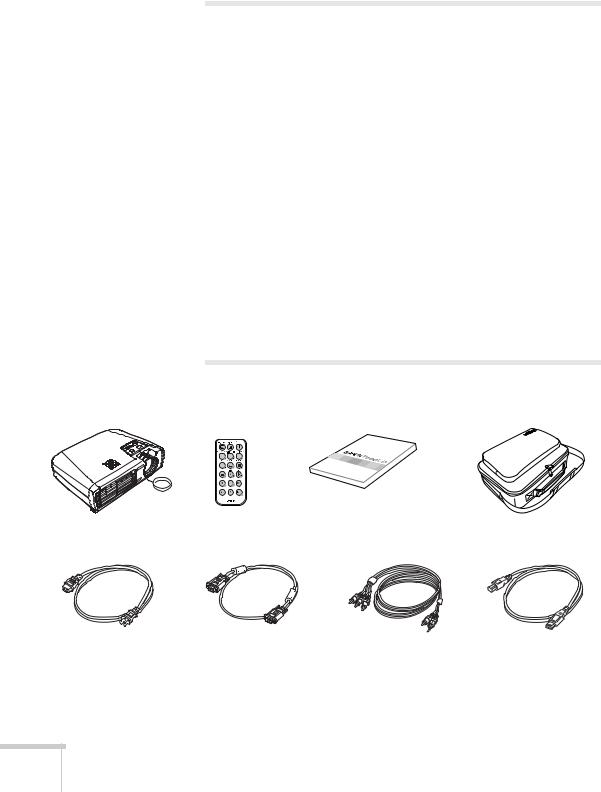
 Registration and Warranty
Registration and Warranty
Your projector comes with a basic carry-in warranty and an international warranty that let you project with confidence anywhere in the world. For details, see page 96 and the warranty brochure included in your Start Here kit.
In addition, EPSON offers free Extra CareSM Road Service. In the unlikely event of an equipment failure, you won’t have to wait for your unit to be repaired. Instead, EPSON will ship you a replacement unit anywhere in the United States or Canada, usually via overnight delivery. See the brochure in your Start Here kit for details.
To register, complete the registration form in your Start Here kit and mail it to EPSON. Or register your product online at:
http://www.epson.com/webreg
Registering also lets you receive special updates on new accessories, products, and services.
 Unpacking the Projector
Unpacking the Projector
After unpacking the projector, make sure you have all these items:
Projector |
Remote control |
Documentation |
Soft carrying case |
Power cord |
VGA computer cable |
RCA A/V cable |
USB mouse cable |
10 Welcome

Save all packaging in case you need to ship the projector. Always use the original packaging (or equivalent) when you need to send the projector to another location.
If you are moving the projector by hand, use the carrying case included with the projector.
 Additional Components
Additional Components
Depending on how you plan to use the projector, you may need additional components:
■To receive an S-Video signal, you need an S-Video cable. One is usually provided with your video device, or you can purchase it from EPSON. See page 12.
■To receive a component video signal from a VCR or other video device, you need a D-sub, 15-pin, VGA-to-component video cable, which is available from EPSON. See page 12.
■To amplify your computer’s audio through the projector’s sound system, you need a computer audio cable (male-to-male 3.5-mm stereo miniplug cable). See your computer or electronics dealer to obtain this cable.
■Some older PowerBooks and Macintosh desktop models may need the Macintosh adapter set shown on page 17 (available from EPSON, as described on page 12). Older iMac systems may need a special adapter to provide a VGA output port; see your computer dealer.
Welcome 11

 Optional Accessories
Optional Accessories
To enhance your use of the projector, EPSON provides the following optional accessories:
Product |
Product number |
|
|
Replacement lamp |
V13H010L27 |
|
|
Air filter set (includes 5 filters) |
V13H134A05 |
|
|
Samsonite® wheeled soft case |
ELPKS24 |
Soft shoulder bags (projector/laptop) |
ELPKS43 |
ATA molded hard-shell carrying case |
ELPKS45 |
|
|
Replacement remote control |
V12H007T13 |
|
|
Component video cable (VGA-to-RCA) |
ELPKC19 |
|
|
S-Video cable |
ELPSV01 |
|
|
Macintosh adapter set |
ELPAP01 |
|
|
50-inch portable screen |
ELPSC06 |
60-inch portable pop-up screen |
ELPSC07 |
80-inch portable pop-up screen |
ELPSC08 |
|
|
High resolution document imager |
ELPDC02 |
High resolution document camera |
V12H064020 |
|
|
Kensington® security lock |
ELPSL01 |
Ceiling mount |
ELPMB39 |
False ceiling plate |
ELPMBFCP |
Suspension adapter |
ELPMBAPL |
|
|
You can purchase these accessories from your dealer, by calling EPSON at (800) 873-7766, or by visiting the EPSON StoreSM at www.epsonstore.com (U.S. sales only). In Canada, please call (800) 463-7766 for dealer referral.
12 Welcome

Setting Up the Projector
This chapter tells you how to set up the projector and connect it to a computer or video source. You can connect up to two devices simultaneously: two computers or two video sources or one of each.
You’ll find instructions for the following in this chapter:
■Positioning the projector
■Connecting to a computer
■Connecting to video sources
Setting Up the Projector 13
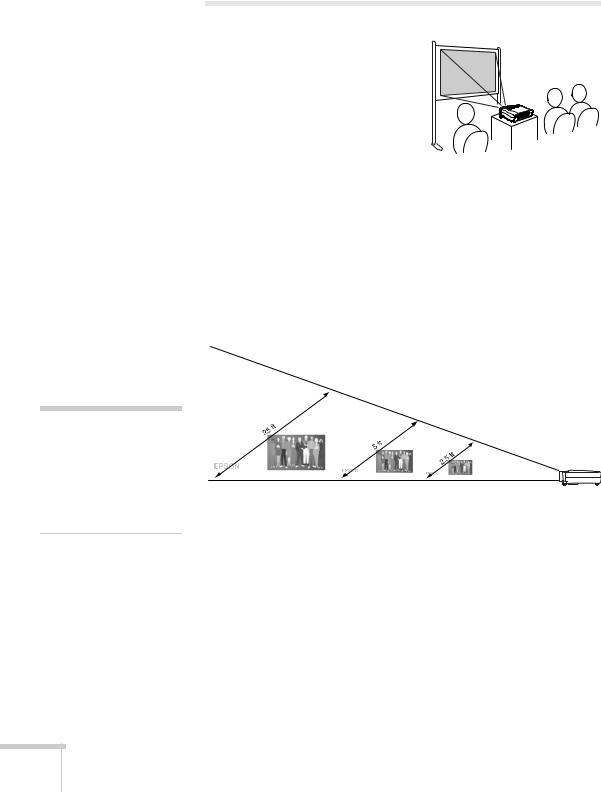
 Positioning the Projector
Positioning the Projector
Before connecting the projector, you need to decide where to place it. If you’re setting up the projector yourself and it isn’t already installed in the room you’re using, you’ll probably want to place it on a table in front of the screen, as shown.
This lets you stand in the front of the room, face the audience, and remain close enough to the equipment to be able to control it. Try to leave as much space as possible between the projector and the screen to get a good-size image.
Place the projector somewhere between 3 and 35 feet from the screen. Use the figure below to help you determine exactly how far. Image size increases with distance, but can vary depending on how you’ve adjusted the optical zoom and other settings.
note
You can download the Projection Distance Calculator program from the Drivers and Downloads section of EPSON’s web site: http://epson.com.
|
|
|
|
|
|
|
|
|
|
|
|
|
|
|
|
|
|
|
|
|
|
|
|
|
|
|
30 to 35.5 feet |
5.9 to 6.8 feet |
2.9 to 3.4 feet |
||||||
Also keep these considerations in mind:
■Place the projector on a sturdy, level surface.
■Make sure there is plenty of space for ventilation around and under the projector. Do not set the projector on top of loose papers that could block the vents under the projector.
■Make sure the projector is within 6 feet of a grounded electrical outlet or extension cord.
14 Setting Up the Projector

Try to place the projector directly in front of the center of the screen, facing it toward the screen squarely. If the projector isn’t positioned this way, the image will be “keystone” shaped, instead of square or rectangular.
If you place the projector below the level of the screen, you’ll have to tilt it up by extending the feet. This also causes the image to lose its rectangular shape, but the Auto Keystone feature corrects the distortion automatically. If the image does not regain its rectangular shape, the tilt angle is greater than 15° or the Auto Keystone feature may have been disabled. To turn it on, see page 52. To adjust it manually, see page 35.
note
The Auto Keystone feature corrects vertical distortion automatically. For more information, see page 35.
Other Installations
You can also project from behind the screen or from the ceiling, with the projector mounted upside-down:
Rear projection (using a |
Rear/ceiling projection (using |
Front/ceiling projection |
|||||||||||||
translucent screen) |
a translucent screen) |
|
|
|
|
|
|
||||||||
|
|
|
|
|
|
|
|
|
|
|
|
|
|
|
|
|
|
|
|
|
|
|
|
|
|
|
|
|
|
|
|
|
|
|
|
|
|
|
|
|
|
|
|
|
|
|
|
To project from overhead, you’ll need the optional ceiling mount hardware. (See page 12 for ordering information.) You’ll also need to select Front/Ceiling or Rear/Ceiling for the Projection option in the Advanced menu. To project from the rear, select Rear. See page 53 for more information.
Setting Up the Projector 15

note
If you have an iBook with an RCA video-out port, follow the instructions for connecting to a video device on page 22.
note
If your computer provides video output through BNC connectors, you can use the optional VGA-to-BNC cable instead. See page 12.
 Connecting to a Computer
Connecting to a Computer
You can connect the PowerLite projector to any Macintosh or IBM®-compatible PC that has a standard video output (monitor) port, including PC notebook and laptop computers, Macintosh PowerBooks and iBooks, and hand-held devices. You can connect two computers at the same time.
Follow the instructions in this section to:
■Connect the VGA computer cable to the projector
■Connect your computer’s monitor cable to the projector (if you want to view your display on the desktop computer screen)
■Connect the mouse cable (if you want to use the remote control as a mouse)
■Connect an optional audio cable (if you’ll be projecting with audio)
Connecting the VGA Computer Cable
Before you start, make sure your computer and the projector are turned off.
1.If you are connecting the projector to a desktop computer, disconnect the monitor cable from your computer.
2. Locate the VGA computer cable that came with the projector.
VGA computer cable
16 Setting Up the Projector
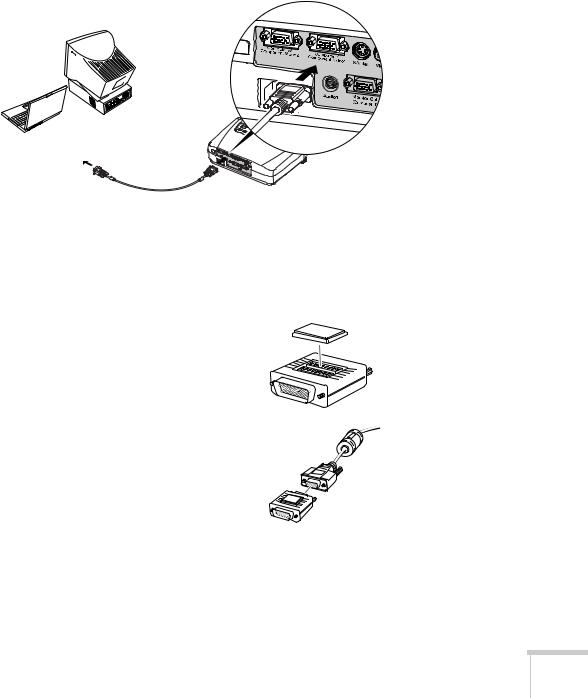
3.Connect one end of the cable to the projector’s
Computer1/Component Video1 or the Computer2/Component Video2 port. If you are going to connect your computer monitor to the projector for simultaneous display, use the Computer1/Component Video1 port.
4.Connect the other end of the cable to your computer’s video-out or monitor port.
If you’re using a PowerBook or iBook and you can’t connect the cable, you may need to use the Macintosh desktop adapter as shown below (available from EPSON; see page 12).
To use the adapter, remove its cover as shown and set its DIP switches according to the resolution you want to use, such as 16-inch mode. See your Macintosh documentation for instructions.
Replace the cover and connect the adapter to the free end of the computer video cable. Then plug the cable (with the adapter) into the video port on your Macintosh.
5.If you want to view the display
simultaneously on your computer monitor and the projector screen, see “Connecting a Monitor” on page 18.
6.Tighten the screws on the connectors.
Setting Up the Projector 17

note
Some LCD monitors may not be able to display the image correctly. If you have trouble displaying the image, connect a multiscan monitor. If you’re projecting computer images, make sure the computer’s refresh rate is set to 65 Hz or greater.
After projection starts, select the correct source (either Computer1 or Computer2) when you want to project this source. See page 30.
If you don’t need to make any other connections, you can plug in your projector and turn it on. See page 28 for instructions.
Connecting a Monitor
If you want to see your presentation close-up as well as on the screen, you can connect an external monitor to the projector. This lets you view images on your computer monitor while the projector is in standby mode (plugged in but not turned on) and check your presentation or switch between picture sources even if you’ve pressed the A/V Mute button to turn off projection on the screen.
Simultaneous display is possible only when the computer is connected to the projector’s Computer1/Component Video1 port.
Make sure the projector and computer are off. Then connect the monitor’s cable to the projector’s Monitor Out port, as shown:
If you don’t need to make any other connections, you can plug in your projector and turn it on. See page 28 for instructions.
18 Setting Up the Projector

Connecting the Cable for Remote Mouse Control
Using the remote control as a wireless mouse lets you click through slideshow-style presentations, such as PowerPoint, from up to 20 feet away. This makes it easy to deliver your presentation, since you won’t need to stand near your computer.
To use the wireless mouse function, your system must have a USB port and the full version of one of these operating systems:
Windows |
Macintosh |
|
|
Windows 98, 2000, Me, and XP |
Macintosh OS 8.6 to 9.2, OS X |
|
|
1.If you are using a desktop computer, disconnect the mouse cable from your computer.
2.Locate the USB mouse cable that came with the projector and connect the square end of the cable to the projector’s  USB port.
USB port.
3.Connect the flat end of the cable to an available USB port on your computer.
4.If necessary, configure your laptop to work with an external mouse.
If you don’t need to make any other connections, you can plug in your projector and turn it on. See page 28 for instructions.
Setting Up the Projector 19
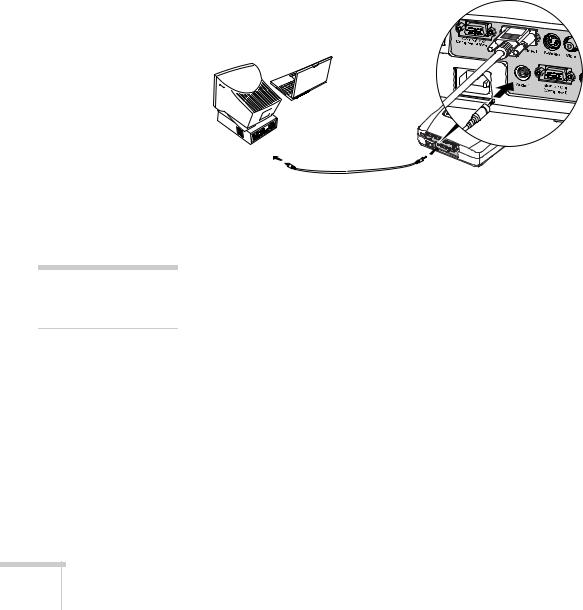
note
The Audio menu also lets you adjust the volume.
Amplifying Computer Audio
Your computer probably has its own sound system; however, it may not be adequate for your presentation. If you need more volume, you can connect a computer audio cable to take advantage of the projector’s built-in amplifier and speaker. You can obtain a computer audio cable (3.5-mm stereo miniplug cable) from a computer or electronics dealer.
1.Connect one end of the audio cable to the Audio1 jack on the projector.
2. Connect the other end of the audio cable to your laptop’s

 headphone jack or
headphone jack or  audio-out jack, or your desktop’s speaker or audio-out port.
audio-out jack, or your desktop’s speaker or audio-out port.
3.After you turn on your projector, open the Audio menu and make sure Audio 1 is selected for the Audio Input setting. See page 51.
If you don’t need to make any other connections, you can plug in your projector and turn it on. See page 28 for instructions.
20 Setting Up the Projector

Connecting to a High-End Workstation
Your PowerLite projector is capable of remapping input resolutions up to 1600 × 1200 pixels (on the PowerLite 74c) or up to
1280 × 1024 pixels (on the PowerLite 54c). Since 1280 × 1024 pixels is the default resolution for most leading workstations, your projector is ideal for displaying workstation video output.
There is no standard for workstation video output. Workstations that follow the SXGA standard and use the HD15 (standard VGA) connector won’t need an adapter cable or any special connection device. However, your system may vary; contact your computer dealer if you need help connecting your workstation.
Setting Up the Projector 21

note
The projector does not support TV antenna cable F connectors.
 Connecting to Video Sources
Connecting to Video Sources
You can connect a DVD player, VCR, camcorder, laser disc player, digital camera, gaming console—such as Microsoft Xbox, Sony PlayStation 2, or Nintendo GameCube—or any other compatible video source to your projector. You can connect up to two video devices at time (or one computer and one video device).
The projector supports HDTV, NTSC, PAL, and SECAM, and automatically detects the video format. It can receive composite video, S-Video, and component video. The type of cable you need depends on the video source:
■For composite video, use the RCA A/V cable included with the projector. See below.
■For S-Video, use the S-Video cable supplied with your video device or order one from EPSON (ELPSV01). See page 24.
■For RGB video, use the VGA computer cable included with the projector. See page 25.
■For component video, you’ll need the optional EPSON component video cable (ELPKC19). See page 26.
Connecting a Composite Video Source
Before starting, make sure the projector and your DVD player or other video source are turned off.
1. Locate the RCA A/V cable that came with your projector.
22 Setting Up the Projector

2.Connect the yellow RCA plug on the two-connector end of the cable to the projector’s yellow Video jack as shown below.
3.Connect the other yellow plug to the video-out jack on your video source.
4.To play sound through the projector, connect the black audio plug on the RCA A/V cable to the projector’s Audio2 jack.
5.Connect the red and white plugs on the other end of the cable to the corresponding audio output jacks on your video source.
6.After you turn on your projector, be sure to:
■If more than one device is connected to the projector, select Video when you want to project this source. See page 30.
■Open the Audio menu and make sure Audio 2 is selected for the Audio Input setting. See page 51.
note
The Audio menu also lets you adjust the volume.
Setting Up the Projector 23
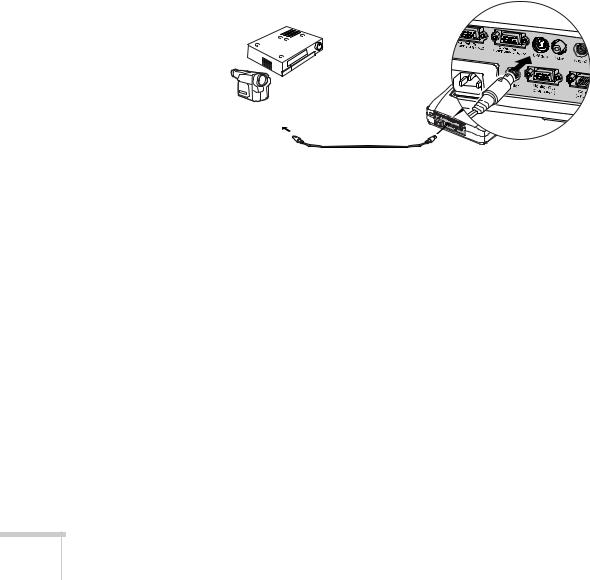
Connecting an S-Video Source
If your video source has an S-Video jack, you can use it to project a higher quality video image. You’ll need an S-Video cable, which is usually provided with your video source, or you can purchase one from EPSON. See page 12.
Before starting, make sure the projector and your DVD player or other video source are turned off.
1.Insert one end of the S-Video cable into the projector’s S-Video port and the other end into the S-Video output port of your video source.
2.If you want to play sound through the projector, connect the audio plugs on the RCA A/V cable as described on page 22.
3.After you turn on your projector, be sure to:
■If more than one device is connected to the projector, select S-Video when you want to project this source. See page 30.
■Open the Audio menu (if you connected the audio cable) and make sure Audio 2 is selected for the Audio Input setting. See page 51.
24 Setting Up the Projector
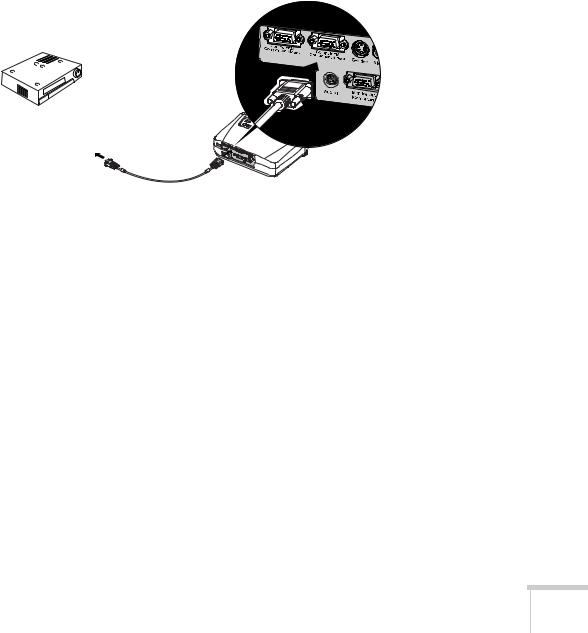
Connecting an RGB Video Source
Follow these instructions to connect the projector to a video player that has an RGB video output port using the VGA computer cable that came with the projector.
1.Connect one end of the VGA computer cable to the
Computer1/Component Video1 or the Computer2/Component Video2 port on the projector.
2.Connect the other end to the video port on your player.
3.If you want to play sound through the projector, connect the optional audio cable (3.5-mm stereo miniplug) as described on page 20.
Once the projector is turned on, be sure to select Computer 1 or Computer 2 (whichever port you used) as the source to see your image. See page 30.
Setting Up the Projector 25
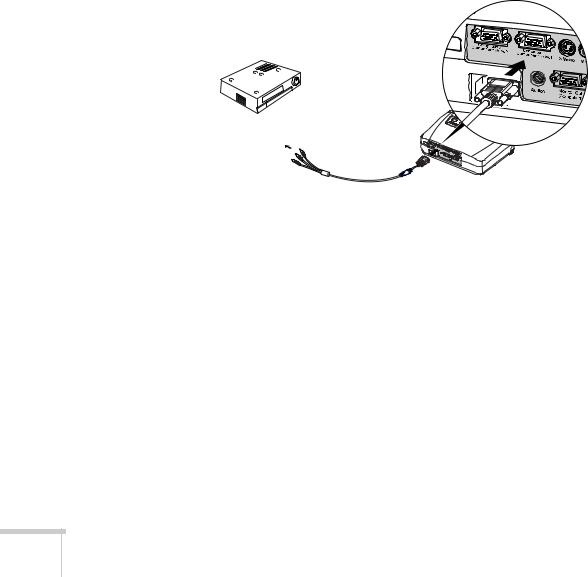
Connecting a Component Video Source
If your video source has component video connectors, you can use them to project a higher quality video image. You’ll need a component video cable, which can be purchased from EPSON (ELPKC19). See page 12.
Before starting, make sure the projector and your DVD player or other video device are turned off.
1.Connect the large end of the component video cable to the projector’s Computer1/Component Video1 or the Computer2/Component Video2 port.
2.Insert the three ends of the component video cable into the R, G, and B ports on your video source.
3.Connect the audio plugs on the RCA A/V cable as described on page 22.
4.Once the projector is turned on, be sure to:
■Select the correct source to see your image: Component Video1 (YCbCr), Component Video1 (YPbPr), Component Video2 (YCbCr), or Component Video2 (YPbPr). See page 50.
■Open the projector’s Image menu and select the correct Input Signal setting to match your device and the port you used: Component Video1 (YCbCr), Component Video1 (YPbPr), Component Video2 (YCbCr), or Component Video2 (YPbPr). See page 50.
26 Setting Up the Projector

Using the Projector
Once you’ve set up the projector, you’re ready to turn it on, adjust the image, and give your presentation.
Although you can operate the projector without it, the remote control lets you use additional features. See Chapter 3 for instructions on using the remote. This chapter covers the following:
■Turning on the projector and other equipment
■Adjusting the image
■Shutting down the projector
Using the Projector 27
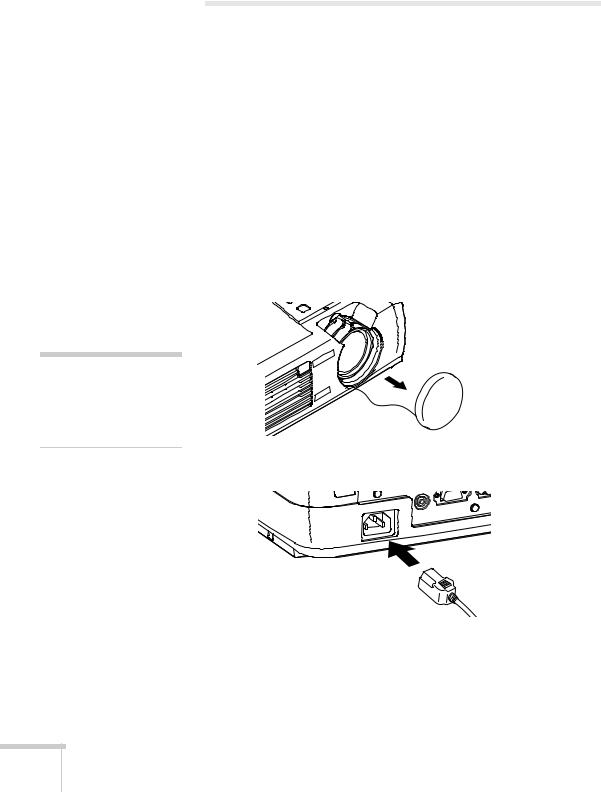
caution
Do not use the projector with the lens cap in place. The heat generated by the lamp can damage it.
 Turning On Your Equipment
Turning On Your Equipment
Make sure your projector and other equipment are set up and connected correctly, as described in Chapter 1. Then turn on your projector, as described below.
If you turn on your connected computer or video equipment before starting the projector, the projector automatically detects and displays the image source. If you turn on the projector first, or have multiple pieces of connected equipment, you may have to select the image source manually. See page 30.
Turning On the Projector
Follow these steps to plug in and turn on the projector:
1. Remove the lens cap.
2. Connect one end of the power cord to the projector’s power inlet.
3.Connect the other end to an electrical outlet.
The power light on top of the projector turns orange, indicating that the projector is receiving power but not yet turned on. Wait until the light stops flashing but stays lit orange.
28 Using the Projector
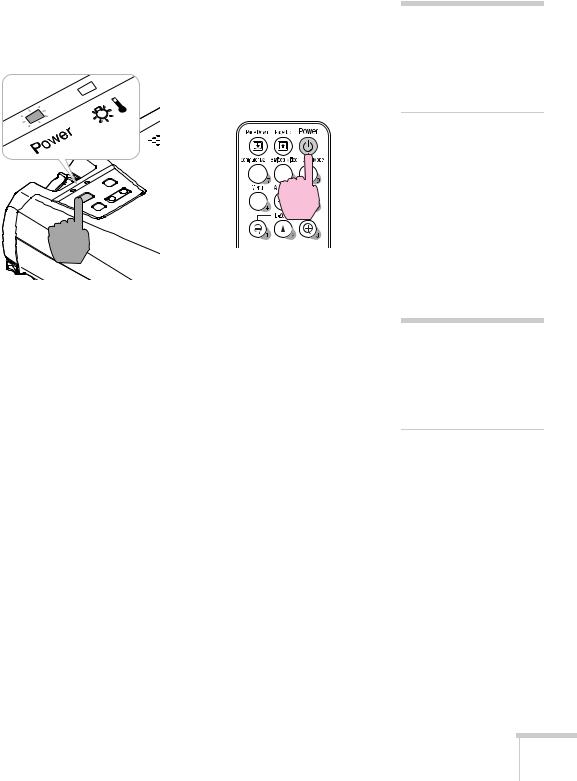
4.Turn on your computer or video source if you have not already.
5.Press the P Power button on top of the projector to turn it on. (You can also press the P Power button on the remote control.)
Page down
Computer
Menu
Auto
note
If you are using the remote control for the first time, be sure to remove the tape from the battery tray as described on page 40.
Projector |
Remote control |
The projector beeps and the power light flashes green as the projector warms up. The lamp comes on in about 30 seconds and the power light stays green.
■If you’re using a computer, you should see your computer display projected after a moment or two. If not, you need to select the image source. See page 30.
(Windows® only: If you see a message saying that it has found a plug-and-play monitor, click Cancel.)
■If you’re projecting a video, press the Source button on top of the projector or the S-Video/Video button on the remote control to switch to your video source. Then press the Play button on your DVD player or other device.
■If you are prompted to enter a password, see page 60.
To focus and adjust the image, see page 33. If a projected image fails to appear, see “What To Do If You See a Blank Screen” below.
When you’re done with your presentation, shut down the projector as described on page 37. Shutting down the projector correctly prevents premature lamp failure and possible damage from overheating.
warning
Never look into the lens when the lamp is on. This can damage your eyes, and is especially dangerous for children.
Using the Projector 29

note
If you don’t hear any sound and adjusting the volume controls does not help, you may need to select the correct Audio port. See page 51.
Selecting the Image Source
Selecting the image source lets you switch between images input from different pieces of equipment connected to the projector (such as a computer and DVD player). If you don’t see the image you want, select it as follows:
■On the projector, press the Source button until the correct device image is projected.
■On the remote control, press the Computer1/2 button to select the device connected to the Computer1/Component Video1 or Computer2/Component Video2 port. For the S-Video or Video port device, press the S-Video/Video button.
If a projected image fails to appear, see the next section for help.
Once you see your image, turn to page 33 for instructions on focusing and making other image adjustments.
What To Do If You See a Blank Screen
If you see a blank screen or a blue screen with the message No Signal after turning on your computer or video source, try the following:
■Make sure the cables are connected correctly, as described in Chapter 1.
■Make sure the power light is green and not flashing and the lens cap is off.
■Press the Source button on top of the projector to select the correct source. (Allow a few seconds for the projector to sync up after pressing the button.)
■Check the Input Signal setting in the Image menu to make sure it matches the port to which the device is connected. See page 50.
30 Using the Projector
